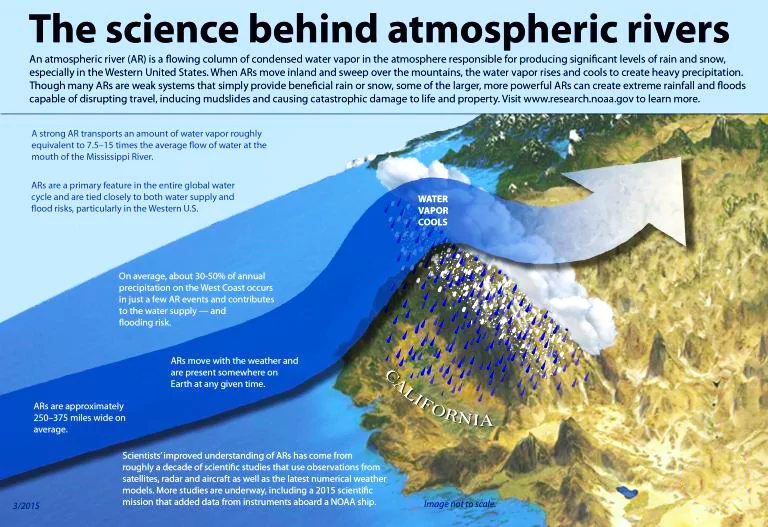Atmospheric rivers are invisible to the naked eye but are growing in intensity over India and contributing to extreme rainfall and deluges.
- Experts are ascribing the recent Wayanad landslide to intensifying monsoon rains and land-use change favoring plantations over forests. But the role of a more ‘invisible’ atmospheric event cannot be overlooked.
About Atmospheric River

Atmospheric Rivers (AR) are pole-bound streams of water vapor fed by the warming oceans in the tropics. As they travel north, they are propelled by strong winds and bring heavy rainfall to areas in their path
- Refers: An atmospheric river is a plume of moisture, or water vapour, that moves from the tropics and is dumped over a region as heavy rain or snow.
- Narrow Bends: Atmospheric rivers are narrow bands that tend to occur on the eastern side of strong mid-latitude storms.
- Impact: It usually causes heavy precipitation and rainfall when it hits the land region.
- Measurement: ARs are identified and measured using a metric called vertical integrated vapour transport (IVT).
- Scientists going through satellite or model data “look for corridors that are greater than 2,000 kilometres long and less than 1,000 km wide that have at least 2 centimetres of vertically integrated precipitable water.
Enroll now for UPSC Online Classes
Impact of Atmospheric Rivers in India
India has also seen its impact during 1985 and 2020. During this period, India’s 70% flooding was due to atmospheric rivers. The southern region of western ghats and eastern ghats of India face major issues like heavy rainfall and precipitation.
- High Heat and Rainfall: Among the climate change-induced factors causing this increase in rainfall intensity is a meteorological phenomenon known as ‘atmospheric rivers’ (AR).
- Humid heat in summers and heavy rainfall during the monsoon is usual for the subcontinent but the intensity of both has palpably increased in recent years. The monsoon months from July-September have become wetter, along with erratic precipitation patterns as the world warmed.
- In the last five years, the number of stations receiving ‘very heavy’ and ‘extremely heavy rainfall’ in July has more than doubled across the country, hitting a high of 1,113 and 205, respectively, in 2023.
- More Landslides and Flash Floods: As per the Indian Institute of Tropical Meteorology, there is higher fluctuation in the moisture transported towards the Indian subcontinent during the monsoon season. As a result, there are short spells when all that moisture from the warm seas is dumped by the atmospheric rivers in a few hours to a few days. This has led to increased landslides and flash floods across the country.
- Both the maximum and minimum IVT of AR over land have increased in India since the 1950s, indicating a strengthening of these systems. The most prominent increase happened in peninsular India and the Indo-gangetic plain.
- These are also the regions in the country which have seen the deadliest floods in the last few years, including the ongoing season.
- Change in Microclimate: Naturally, at greater intensity, they can significantly alter the microclimate of places it moves through, stuffing the air with water vapour, increasing wind speeds and causing violent showers.
Various Reports Findings
In India, its formation is largely caused by sea surface temperature in the south-central Indian ocean. Evaporation has increased in the Indian ocean due to higher Vapour Pressure Deficit (VPD). VPD is a measurement unit that measures the pressure needed to turn liquid into vapour.
- Journal Nature 2023: 70% of all major floods in the country in the last 35 years were associated with ARs.
- Moreover, 65% of all landfalling ARs in the period led to floods.
- ARs can sometimes carry many times the volume of moisture and flow at a higher speed than some of the world’s major rivers.
- Moreover, they hover much closer to land than the dry jet streams and pick up moisture moving over the vast, warm oceans, which they shed while traversing over land.
- Nature Study: The researchers of the Nature study observed the arrival and impact of these moisture conveyors over India from 1950-2020.
- They noted that 596 ‘major’ AR events occurred in the country during the period, almost all during the summer-monsoon months from June-September.
- Moreover, the month of July, when the devastating Wayanad floods occured, recorded the most number of days (28%) with an AR event.
- Atmospheric Research: In 2021, it illustrated the association between floods and ARs for Kerala specifically. It noted that “a multi-day AR in the second week of August 2018 was pivotal in causing extreme precipitation over the south-west coast of India that eventually led to record-breaking floods”.
Check Out UPSC NCERT Textbooks From PW Store
![]() 6 Aug 2024
6 Aug 2024

